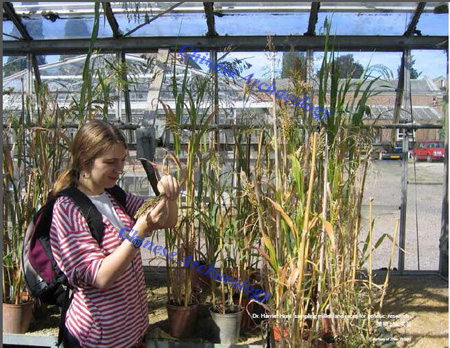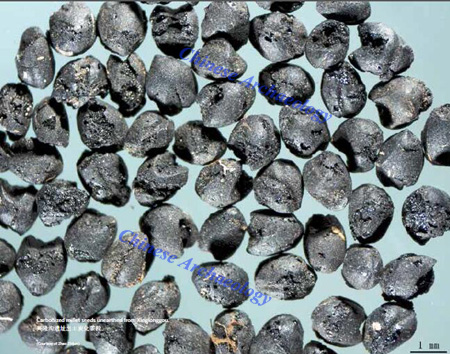The Origin and Spread of Broomcorn and Foxtail Millets
From:Chinese Archaeology NetWriter:Zhao ZhijunDate:2015-12-25
Hardy, small-grained cereals have received less scientific attention than their high-yielding, large-grained counterparts, in particular, wheat, rice and maize. Scholars from Beijing, Cambridge and St. Louis are researching two of the hardiest of these smallgrained cereals, broomcorn and foxtail millet, and raising awareness of their past, present and future utility. They have established that Panicum miliaceum and Setaria italica , today two minor cereals in decline and attracting little scientific attention, were once among the most expansive in geographical terms, with a centre of origin in northern China, but spreading to Europe and India in prehistory.In this century, the technique of flotation was introduced to Chinese archaeology. As a result, a tremendous amount of plant remains have been recovered from archaeological sites located all over China. An important case where millets have been recovered comes from the early Neolithic site of Xinglonggou in Inner Mongolia. More than 1400 charred millet grains were recovered (predominantly broomcorn, but also some foxtail millet). Radiocarbon dating was carried out using the broomcorn millet with AMS by three laboratories located in China, Canada and Japan. The weighted mean value for the four dates is 6800±35 14C BP or 7670- 7610 calibrated years BP. They constitute the oldest directly dated millet grains across Eurasia.
Another site where large numbers of millet remains have been found is Yuhuazhai in Xi’an City. About 50,000 charred millet grains (including both foxtail and broomcorn millets) have been recovered from four different layers of the site dated to ca. 7000-5500 BP. The changes in the morphological characteristics of the millets from different layers reveal a slow process of millet domestication, which occurred over thousands of years.
Alongside the growing archaeobotanical record, we are collaborating to advance the analysis of the origins and spread of millet agriculture on a number of methodological fronts. These include archaeogenetics, isotopic dietary studies and biomarker analysis. Genetics reveals much of the ancestry and something of the biological characteristics of the plant. At the outset, the genetic record for broomcorn millet was even sparser than the archaeobotanical record. Archaeogenetic research initially offered two explanations for millet phylogeography. Based on additional evidence, one of these proved to be the most parsimonious explanation, indicating that the ancestor of all broomcorn millet worldwide originated in the same region of North China that had given rise to the earliest archaeobotanical evidence for the crop. Our genetic data also revealed that the sticky gene in broomcorn millet also occurred in the relevant region of East Asia, and that there is evidence for the deactivation of that gene in broomcorn varieties that had reached the West.

Dr. Harriet Hunt sampling millet land races for genetic research .
Recently, scholarly attention has turned to early Western records of three crops traditionally associated with China: buckwheat, broomcorn millet and foxtail millet. These minor cereals, which had been rather overlooked, are now elevated to a conspicuous position within Old World prehistory in relation to questions about their origins and spread. The gathering of novel archaeobotanical evidence has intensified across Eurasia, allowing us to publish a much richer and more detailed picture of both potential pathways, and environmental contexts and constraints to the spread of these crops. It is now clear that the core valley bottoms (principally of the Yellow River) were not the primary focus of the first agriculture, which was instead centered on the soft foothill spurs. In some places, for example Xinglonggou and other early Neolithic sites in North China, cultivation was practiced at some considerable distance to the Yellow River, and was more closely connected to water runoff from the mountains gathering in foothill locations. This growing emphasis upon foothill locations, and the exploitation of slope runoff as opposed to valley bottom water, resonates with important new millet records outside of China.
An environmental context for the origin and spread of millet is now unfolding. Researchers have documented broomcorn millet in eastern Kazakhstan around 4500 years ago. Beyond Central Asia, broomcorn millet spread westward and eventually reached the Caucasus and Europe. Foxtail millet, on the other hand, spread southward from North China, and was documented in sites from Thailand and India no later than 4000 years ago.
Our results discussed above have been published by individuals of the project team in many peer-reviewed journals including Science, Kaogu(Archaeology), Current Anthropology, American Journal of Physical Anthropology, Antiquity, World Archaeology, Vegetation History and Archaeobotany, Molecular Ecology, and Molecular Biology Evolution.

Carbonized millet seeds unearthed from Xinglonggou.
The research has been funded by initiatives from around the globe including the National Science Foundation of China, Innovation Project of CASS, and the National Science and Technology Support Project of Ministry of Science and Technology in China; the European Research Councilinthe EU; the Wellcome Trust, the Leverhulme Trust, Royal Society of London, the Dorothy Hodgkin Award, BBSRC, Unilever, Bioscience, Darwin College, and Cambridge in the UK; Gerda-Henkel Stiftung in Germany; and the Wenner Gren Foundation, the Gates Foundation, I-CARES and Washington University in St. Louis in the US.
Our research group has successfully established an extensive international network of collaborations. More than twenty scientists from eight nations are involved in the collaborations and have contributed to the project at various stages. Fieldwork has been carried out in China, Russia, Kazakhstan, India, Ukraine and Romania, followed by subsequent lab based analyses in China, the UK and the USA. We would like to highlight the excavation of Xinglonggou led by Liu Guoxiang from CASS, plant identification by Yang Jingang, data management and analysis by Sun Yonggang from Chifeng University, and the works done by Harriet Hunt from Cambridge and Giedre Motuzaite-Matuzeviciute from Vilnius, for their important contributions to the understanding of the genetic diversity and radiocarbon ages of broomcorn and foxtail millet. We would also like to acknowledge following people who contribute significantly to the project through their participations, publications and collaborations. They are: Wang Wei from Institute of Archaeology CASS, Zhou Liping from Peking University, Emma Lightfoot, Natalia Przelomska, Penny Jones, Diane Lister, Ting Anand Catherine Kneale in Cambridge, Dorian Fuller and Michael Rowlands in London, and Michael Frachetti and Robert Spengler in Washington University in St. Louis.
Zhao Zhijun
ZHAO Zhijun is a professor at the Institute of Archaeology, Chinese Academy of Social Sciences. He received his Ph.D. degree in Anthropology in 1996 from the University of Missouri, with advanced work emphasizing archaeobotany. He is one of pioneers of his research field in Chinese archaeology, and promoted the use of flotation technique in archaeological excavation in China. He has participated in fieldwork to carry out flotation that involved more than one hundred archaeological sites distributed all over China. His research interest is focused on the origin of agriculture. This involves a range of approaches from fieldwork to laboratory experiments. His recent works focus on the economic background of ancient Chinese civilization and the spread of crops in prehistoric times. His publications include a book entitled “Paleoethnobotany – Theories, Methods and Practice”, as well as about 80 articles and archaeological reports.
Martin Jones
Martin Jones is the first George Pitt-Rivers Professor of Archaeological Science at the University of Cambridge, and Vice-Master of Darwin College, Cambridge. For forty years he has published reports of his archaeobotanical research into the nature and development of agriculture in different parts of the world. In the 1990s, his work expanded from archaeobotany to embrace the novel field of archaeogenetics, subsequently engaging with stable isotope palaeodietary studies. He has been elected a member of the Academia Europaea. Over the last decade, a series of projects funded primarily by the Wellcome Trust, the Leverhulme Trust, Darwin College, and the European Research Council have allowed Professor Jones to collaborate closely with Chinese colleagues to explore and analyze the evidence for Old World millet cultivation.
Liu Xinyi
LIU Xinyi is an assistant professor at the Department of Anthropology, Washington University in St. Louis. He has been applying multiple methods to study episodes of food globalization in prehistory. Graduating from Cambridge in 2010, he had previously worked at the McDonald Institute for Archaeological Research as a post-doctoral researcher, and as a junior research fellow at Darwin College, University of Cambridge. Since 2005, he has been conducting research on the origin and early spread of millet, initially advised by Prof. Martin Jones and assisted by Prof. Zhao Zhijun.
(Zhao Zhijun Institute of Archaeology at Chinese Academy of Social Sciences; Martin Jones Cambridge University; Liu Xinyi Washington University in St. Louis)
(Source: Research Center for World Archaeology, Shanghai Academy)

